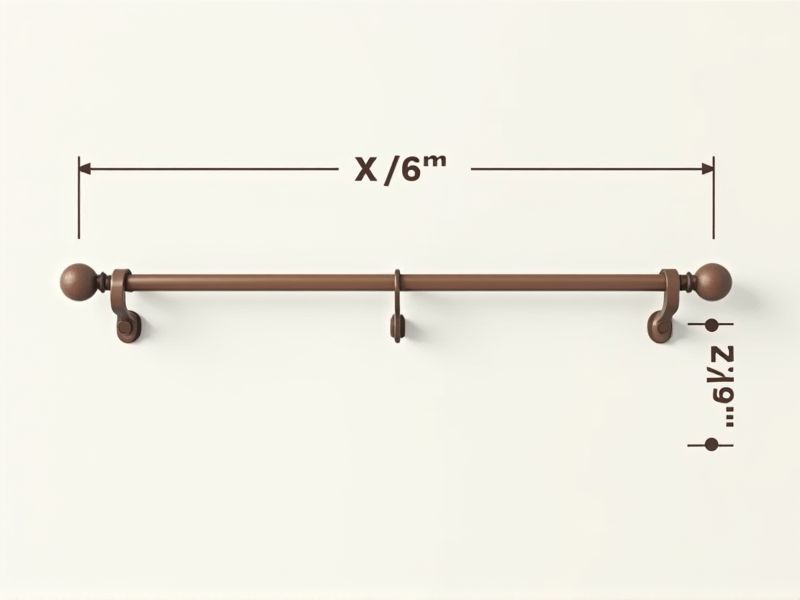
When planning for a closet rod, it's helpful to know that the standard height for installation is typically 66 inches from the floor. Most closet rods have a standard diameter of about 1 1/4 inches, providing enough strength for most clothing loads. For reach-in closets, rods are usually spaced at least 12 inches from the back wall to ensure hangers have enough room. Double hanging rods can be installed at 40 inches and 80 inches to maximize vertical storage space for shorter garments like shirts and pants.
Diameter - 1 To 2 Inches
A standard closet rod typically has a diameter ranging from 1 to 2 inches, which ensures robust support for hanging garments. Choosing the right diameter is essential; a rod that's too thin may bend under the weight of heavy clothing, while one that's too thick could be cumbersome to install or use. For optimal performance, your closet rod should match the weight capacity needed, often accommodating 100 to 200 pounds depending on the material used. Consider the spacing and layout of your closet to determine the best diameter that will meet your storage needs.
Length - Varies By Closet Size
The standard length of a closet rod typically ranges from 48 to 72 inches, accommodating various closet sizes. For smaller closets, such as reach-in designs, rods can measure as short as 36 inches. In contrast, walk-in closets often require rods of 80 inches or more to maximize space and accessibility. You can enhance the organization of your closet by selecting a rod length that suits your specific storage needs.
Height From Floor - 66-72 Inches
The standard height for a closet rod typically ranges from 66 to 72 inches above the floor, accommodating most hanging garments efficiently. This height allows for optimal space utilization, ensuring that long dresses and coats can hang freely without touching the ground. If you are designing a closet system, consider the types of clothing you own to maximize accessibility and organization. For shorter individuals, a height closer to 66 inches might be preferable, while taller users might benefit from positioning the rod at 72 inches.
Spacing From Wall - Minimum 12 Inches
The standard spacing for a closet rod from the wall is a minimum of 12 inches to accommodate hangers without crowding. This distance allows for easy access to clothing and maximizes hanging space in your closet. Furthermore, adequate clearance ensures that garments hang freely, preventing wrinkles and maintaining their shape. If you're designing a closet, maintaining this spacing can significantly enhance functionality and organization.
Support Brackets - Every 48 Inches
The standard for closet rod installation emphasizes support brackets placed every 48 inches to ensure stability and weight distribution. This spacing allows each rod to bear significant loads, typically accommodating up to 100 pounds, depending on the material used. Utilizing sturdy brackets enhances the longevity of the rod and minimizes sagging, making your closet more functional. For optimal results, consider metal brackets over plastic, as they provide increased durability and support for heavier garments.
Clearance Below Rod - Adequate For Hanging
The standard clearance below a closet rod is typically 66 inches, ensuring ample space for hanging clothes without them touching the floor. For shorter garments, such as shirts or blouses, a clearance of 48 inches may suffice, allowing them to hang freely. If you plan to store longer items like dresses, aim for a clearance of at least 72 inches. This thoughtful organization maximizes your closet's efficiency and keeps your clothing wrinkle-free.
Double Rod Installation - 42 Inches Apart
A double rod installation allows for efficient space utilization, placing rods 42 inches apart. This configuration provides adequate room for hanging various clothing types, enhancing your organization capabilities. Typically, a double rod setup maximizes vertical space, especially beneficial in smaller closets. For optimal functionality, consider adjustable rods that can accommodate your personal preferences and changing wardrobe needs.
Material - Metal Or Wood
When selecting a closet rod, consider the durability and aesthetic appeal of the material. Metal rods, typically made from stainless steel or chrome, offer strength and resistance to bending or warping, making them ideal for heavy garments. On the other hand, wooden rods, often crafted from sturdy hardwoods like oak or maple, add a natural warmth to your closet space while being suitable for lighter clothing items. Depending on your storage needs and style preference, choosing the right material can enhance both functionality and visual appeal.
Installation Angle - Level Or Slightly Sloped
The ideal installation angle for a closet rod is typically level or slightly sloped, ensuring optimal support for hanging garments. A level rod distributes weight evenly, preventing sagging over time, while a slight slope aids in ensuring that hangers do not slide off. For best results, maintain a slope of approximately 1 inch for every 4 feet of rod length if opting for the sloped option. Properly installed closet rods can enhance the functionality and longevity of your closet space, accommodating various types of clothing without compromising aesthetics.
Weight Capacity - Depends On Material And Installation
The weight capacity of a closet rod is crucial for maximizing storage efficiency and durability. Typically, wooden rods can support 150 to 250 pounds, while metal rods can handle 200 to 500 pounds, depending on thickness and installation methods. Proper installation techniques, such as wall mounting and using sturdy brackets, significantly enhance the rod's load-bearing capacity. Your selection of materials and installation approach will directly impact the functionality and longevity of your closet system.
